On a transit-related discussion forum, this question recently came up:
Was the North Shore the last interurban to end passenger service? I can’t think of any that made it past 1963 and aren’t still around. I know that a few lines lasted longer as exclusively freight operations.
By 1964, Hilton and Due declared that the “Interurban Era” was truly over, following the abandonment of both Pacific Electric and the North Shore Line. Passenger service continues on the Chicago South Shore & South Bend, “America’s Last Interurban,” so that can’t be the answer.
But there is one other possible candidate- the Red Arrow Ardmore branch. Rail service there ended on December 30, 1966, nearly four years after the NSL. (With bus service, it continues as SEPTA Route 103.)
I guess it depends on what you mean by “interurban.” Hilton and Due included Red Arrow in their classic volume, The Electric Interurban Railways In America, but there was a caveat- Red Arrow had some of the characteristics of an interurban.
At the core, interurban means “between cities.” And Red Arrow is more suburban than interurban. Until SEPTA took over in 1970, the Ardmore line was part of the Philadelphia Suburban Transportation Company.
I think most people would agree that the West Chester line was a true interurban. It was the longest by far of the various Red Arrow lines, but it was also the first to go, in June 1954. Ridership was good, but the “side of the road” line fell victim to the widening of West Chester Pike. Buses replaced trolley cars.
Red Arrow’s Norristown High-Speed Line is more rapid transit than interurban, but it did share trackage with a real interurban, Lehigh Valley Transit’s Liberty Bell Limited, at least until 1949. Those trains ran from 69th St. terminal (which is actually in Upper Darby, PA just outside the Philadelphia city limits) to Allentown.
Ardmore, the shortest Red Arrow branch line, also had good ridership, but a number of things worked against the continuation of rail service. There was a car shortage, Red Arrow not being in a position to buy new equipment after about 1950. Red Arrow President Merritt H. Taylor, Jr. said they were two cars away from keeping rail service.
They considered buying the two double-ended Illinois Terminal cars that were saved, but the doors were on the wrong side. And so buses took over from rail, in part over a private “busway.”
The IT cars eventually ran in regular service for a while in Cleveland before going back to railway museums.
Rail service continues today on the former Red Arrow Media and Sharon Hill lines. These too might have been “bussed,” except that Red Arrow would have lost title to the land, rail service being part of the bargain.
Red Arrow thought they might be able to get around this requirement by using a rail bus, which could run on rubber tires over city streets, then convert to steel wheels to run on rails. Fortunately for us, the experiment did not work out.
In the aforementioned Hilton and Due book, the authors say that Red Arrow intended to bus all their lines except Norristown within a few years. Ardmore fell victim to this, but we still have very successful trolley service on Media and Sharon Hill via SEPTA.
Ardmore Junction was by far the best spot for pictures on the line, with the possibility of getting a P&W car and an Ardmore train in the same picture.
We’ve selected some of our favorite pictures from the Philadelphia Suburban Ardmore branch, and we present them for your enjoyment. As we prepare to celebrate Thanksgiving, we have much to be thankful for. I, for one, am thankful there haven’t been more abandonments.
If anything, there are contemporary systems that could also be considered interurbans- the PATCO Speedline between Philadelphia and Lindenwold comes to mind, and BART. But the “Interurban Era” was as much sociological as technological, and it has receded into the past, never to return in its original form.
-David Sadowski
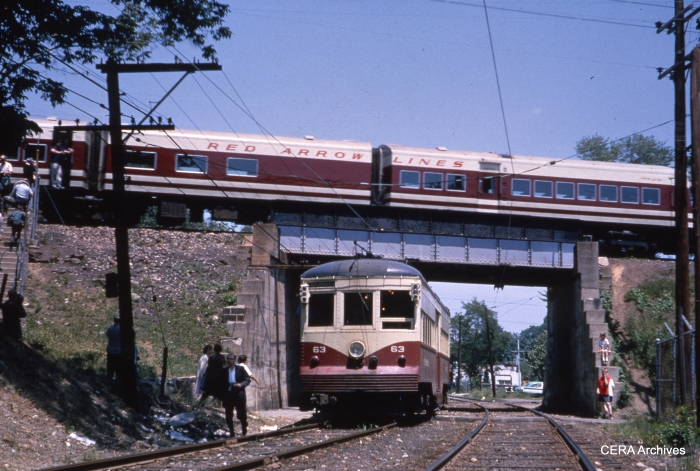
PSTCo 63 and Liberty Liner at Ardmore Junction on May 30, 1964. The Liners had only been in service for a few months. (Photographer unknown)

The Ardmore Terminal, since demolished. (From an old postcard)

Brilliner 1 at Ardmore Junction on May 30, 1964. (Photographer unknown)

PSTCo 12 at Ardmore Terminal on August 6, 1960. (Photographer unknown)

That’s P&W ‘Strafford” car 168 above, and I think that’s Red Arrow car 18 below at Ardmore Junction on November 26, 1954. (Photo by Raymond DeGroote)

PSTCo 63 at Ardmore Station on May 30, 1964. (Photographer unknown)
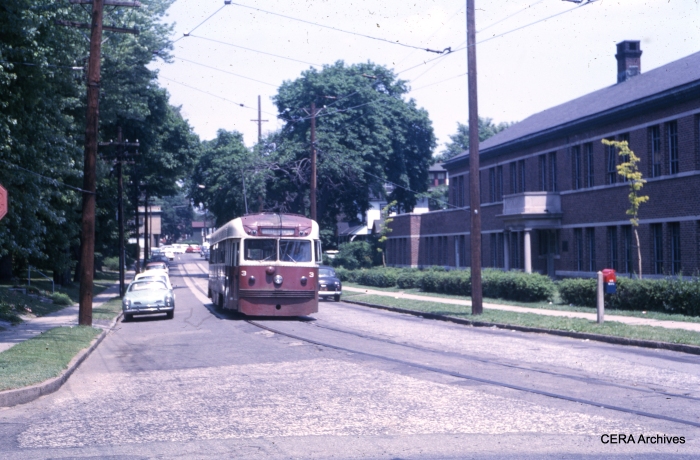
PSTCo 3 street running on Lipincott Street on June 1, 1965. (Photographer unknown)
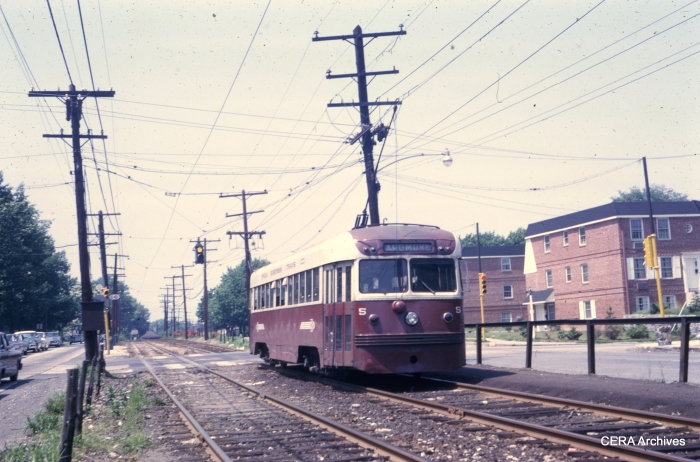
PSTCo 5 at Llanerch Junction on June 1, 1965. (Photographer unknown)
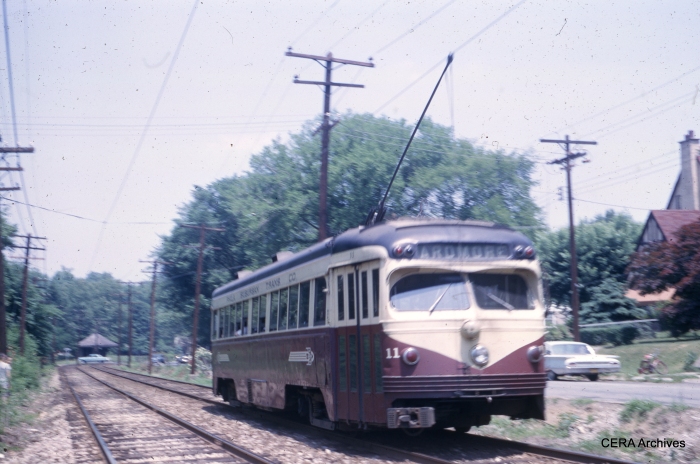
PSTCo 11 on the Ardmore branch on June 1, 1965. (Photographer unknown)

PSTCo 11 on the Ardmore line on June 1, 1965. (Photographer unknown)

Double-ended St. Louis car 13 (don’t call them “PCCs”) at Ardmore Junction on November 26, 1954. (Photo by Raymond DeGroote)
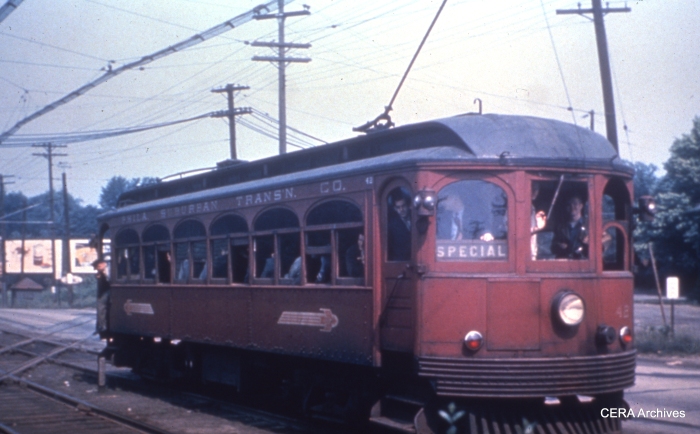
PSTCo 42 at Llanerch car barn on May 8, 1949. (Photographer unknown)
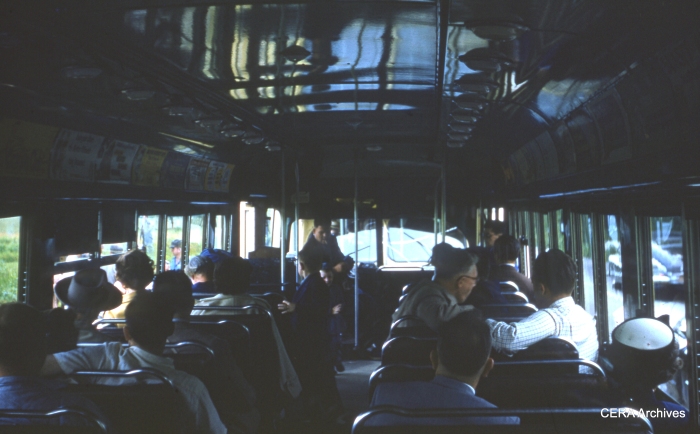
Inside a Red Arrow car in the 1950s. (Photographer unknown)
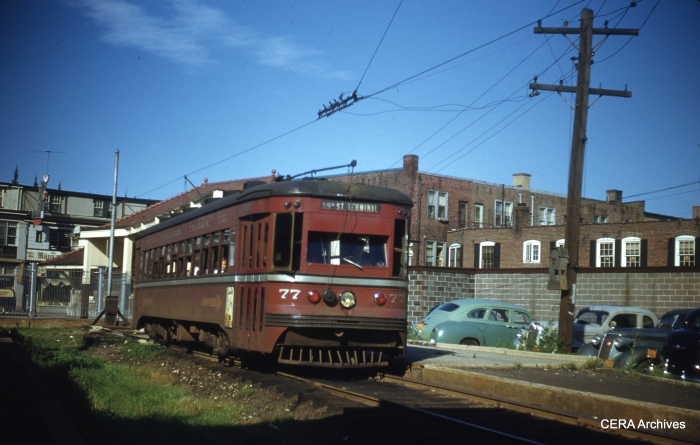
PSTCo 77 at the Ardmore Terminal on July 23, 1949. (Photo by James J. Buckley)
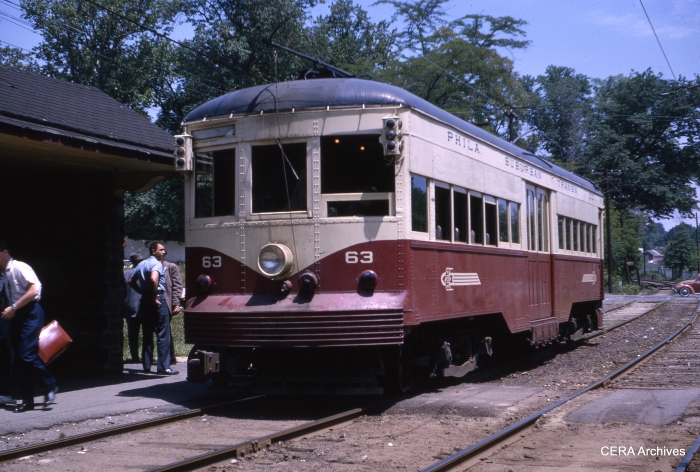
PSTCo 63 at Ardmore Junction on May 30, 1964. (Photo by Charles W. Houser, Sr.)

Brilliner 5 at Ardmore Junction on June 28, 1952. (Photographer unknown)

One of the Red Arrow Liberty Liners meets car 63 at Ardmore Junction on May 30, 1964. (Photographer unknown)

PSTCo 63 at Ardmore Junction on May 30, 1964. (Photographer unknown)

Philadelphia Suburban car 63 at Llanerch Junction on May 30, 1964. (Photographer unknown)
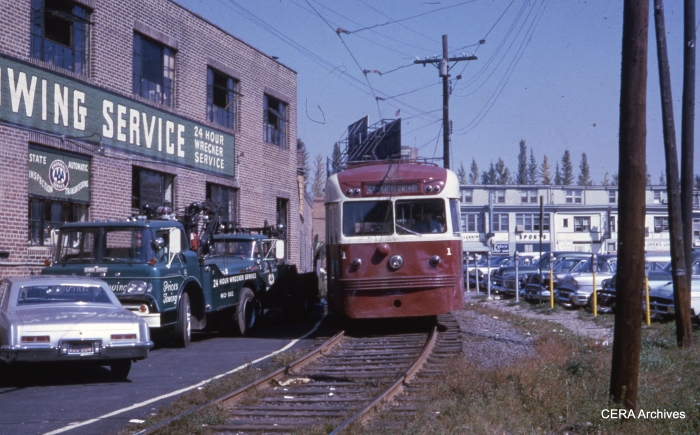
Brilliner 1 near the Ardmore terminal in December 1964. (Photographer unknown)
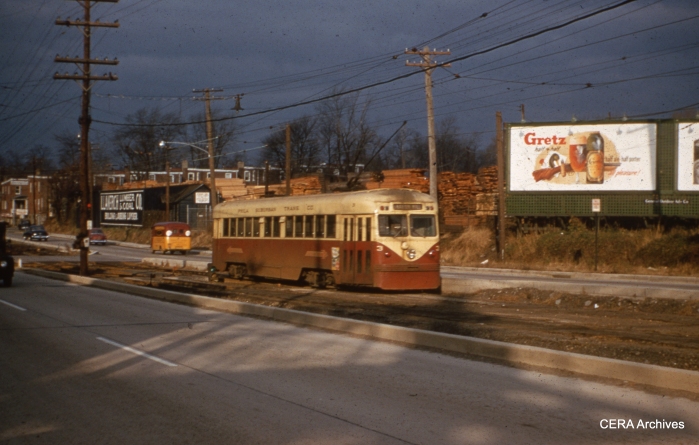
Brilliner 3 along West Chester Pike, near Llanerch Depot, on November 26, 1954. (Photo by Raymond DeGroote)
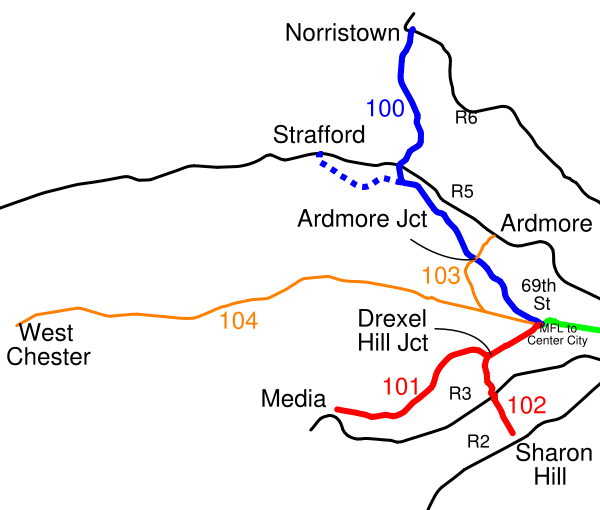
A map showing the historic Red Arrow trolley lines (from the Wikipedia).
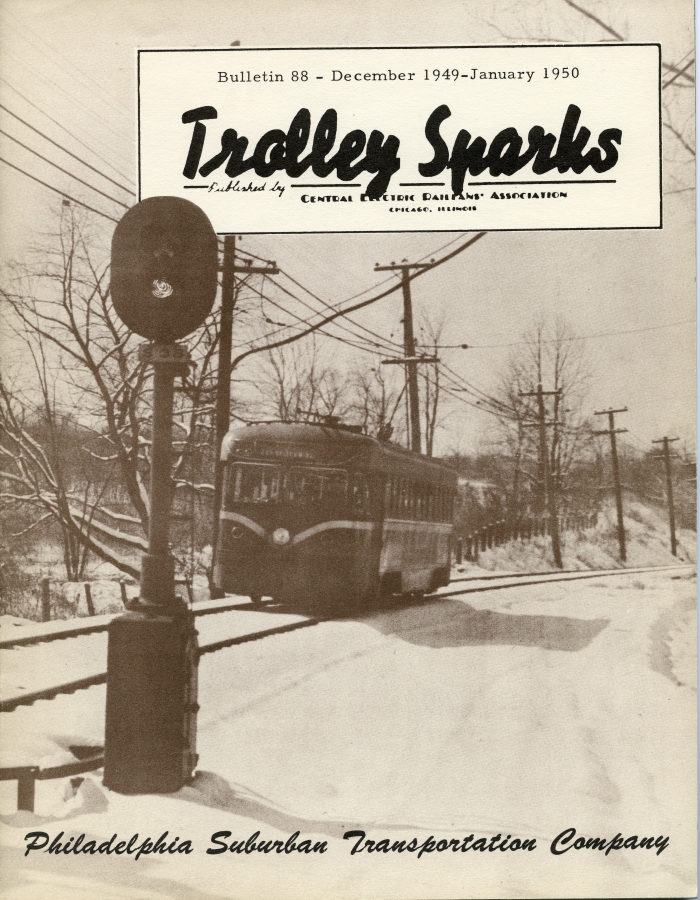
The Red Arrow trolley lines were featured in CERA Bulletin 88.
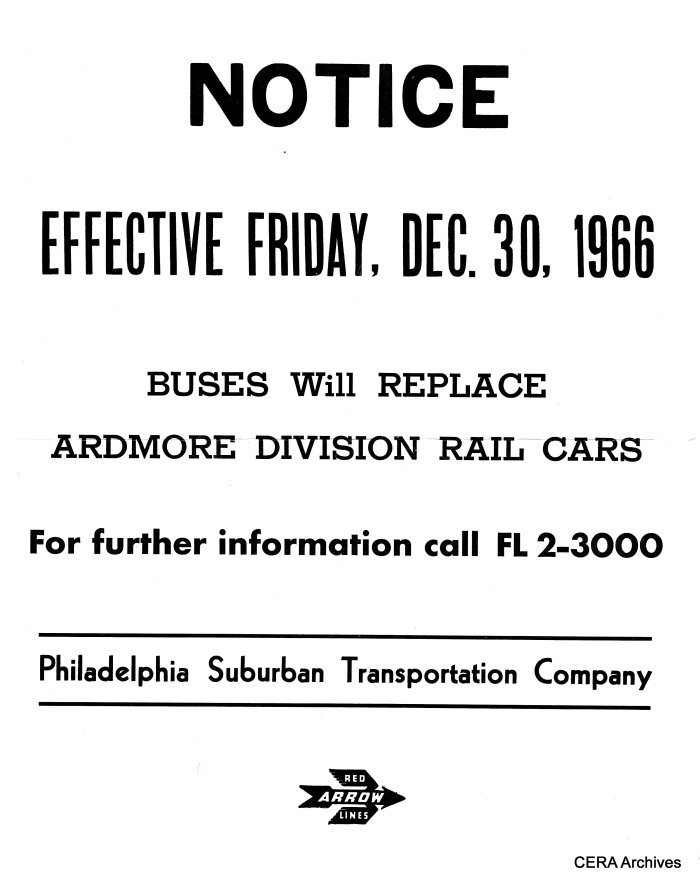
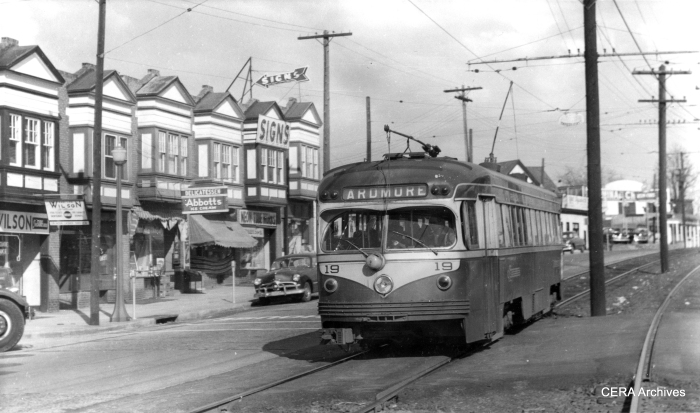
PSTC 19 along the Ardmore line in the early 1950s. (Photographer unknown)

Brilliner 4 at speed on single-track private right-of-way leaving Ardmore in the 1950s. (Photo by Richard H. Young)